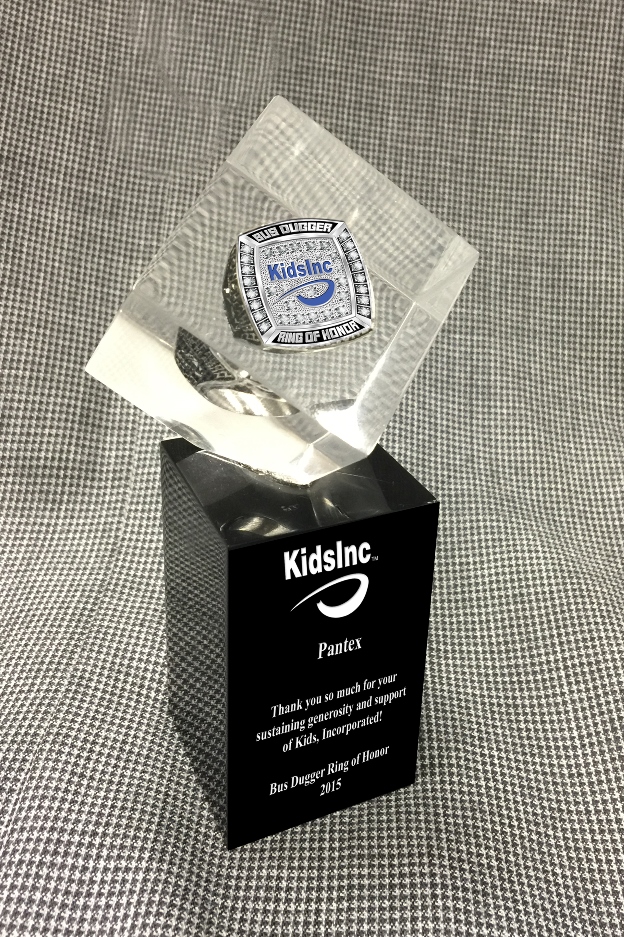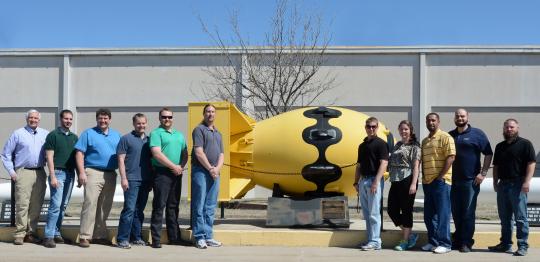Pantex Blog
Kids, Incorporated Honors Pantex with Championship Ring

It is the single goal for every professional sports team…to win a national championship. The prestige and pride is usually accompanied by a one-of-a-kind championship ring that is one of the most prized possessions in all of sports.
Now, Pantex can claim a championship ring, but not for what was done on a field of dreams, well, not directly anyway. It’s a congratulatory gift designed to acknowledge contributions made by Pantex to Kids Incorporated which helps out thousands of local kids with sporting events all year long.
Receiving this championship ring isn’t based on catching a touchdown pass or hitting a home run. It’s about how well Pantex performed off the field and the charitable contributions provided off the field to Kids, Inc. To be a member of this “Ring of Honor,” the contribution column of a business’ score card has to total more than $10,000 in donations.
The ring itself is named after Bus Dugger, the very first coach at Kids, Inc. At 95 years young, Coach Dugger was on hand at the ring ceremony to present his namesake championship finger-sized trophies. In fact, about 60 different businesses were honored as Champions, due to their donations and investment made back into the youth of Amarillo and the surrounding areas.
In 2014, Kids, Inc. had almost 16,000 kids involved in their events. This year, as they celebrate their 70th anniversary, they decided to recognize those organizations and their employees who make these programs possible.
“Pantex was one of the first companies to step up and assist us financially when we began providing medals for the kiddos at the end of each sport," states Jimmy R. Lackey, President & CEO for Kids, Incorporated. “We have many, many volunteers who are employed at Pantex. We are so grateful for the support they provide to our organization."
Pantex Site Manager Michelle Reichert expressed appreciation for the honor and stressed Pantex's commitment to Kids, Inc.
“Pantex and its employees have been long-time supporters of Kids, Incorporated and being recognized with this ‘Ring of Honor’ is something everyone out at the site can be proud of and I gladly accept this on behalf of each and every employee at Pantex,” said Reichert.
Any athlete will tell you that receiving accolades at the end of a successful season is not what competitive sports is all about. It’s about promoting and building team work, having everyone focus on a single goal and performing up to the expectations of what you and your team members committed to doing long before the season began. That is what it takes to become a true champion. In this case, just like the kids on the field of any Kids, Inc. event, Pantex and its employees can also share those same goals as they received a championship ring for their efforts of giving back to the community.
Pantex Employees Bowl for Kids’ Sake

Pantexans are well known for their generosity and going “above and beyond” to help out in their communities and that spirit of giving was never more prevalent than at the recent Big Brothers Big Sisters (BBBS) Bowl For Kid’s Sake. Besides Consolidated Nuclear Security, LLC being a corporate sponsor for this year’s fundraiser, Pantex employees filled lane after lane with bowlers to help raise money and awareness for the mentoring program.
It’s an all-day event with teams coming and going at Western Bowl for bowling fun and bringing in sponsorships that go directly to the BBBS organization, which serves more than 250 young men and women in the Amarillo and Canyon area. Along with those successfully matched, at any one time, BBBS may have up to 150 little brothers and sisters on their waiting list, usually from single parent homes where a young man or woman might not get the one-on-one time with an adult that they need.
At absolutely no cost to the parent, the children, or “Littles” are signed up and then matched up with a “Big” who agrees to spend a few hours a week with their match. Their mission is to help children reach their full potential through professionally supported, one-to-one mentoring relationships. Through fund-raising efforts like Bowl for Kids’ Sake, they are able to keep the program up and running. It’s a huge undertaking for the staff at BBBS, but the rewards are worth every minute spent in fundraising.
“Bowl For Kids’ Sake is one of our agency’s largest fundraisers and accounts for over 30% of our annual budget. Proceeds from the event are dedicated to program costs that directly affect the lives of the children we serve. We are able to help more than 250 children participating in our programs, thanks to our Bowl For Kids’ Sake sponsors,” said Emily Shelton Nance, executive director, BBBS of the Texas Panhandle.
Pantex employees always make up one of the largest groups to be represented with multiple teams being the norm, rather than the exception. Having the site so highly represented is also something that BBBS never takes for granted, and is very thankful for when it comes time each year to let the bowlers roll a pair of games.
“Pantex has been a cherished supporter of Bowl For Kids’ Sake. In the last nine years, more than 147 teams have participated in Bowl and provided needed funding to serve virtually hundreds of children living in our community,” added Nance.
BBBS is planning new and diverse forms of fundraising through the coming months, but it’s a sure bet that Bowl for Kids’ Sake will continue on as usual, with a great feeling of accomplishment from everyone involved, including the Pantexans who will once again takes to the lanes to make a big difference and have a little fun for some “Bigs” and “Littles” who are the real winners.
Pantexans Succeed in Fitness Challenge

While they are extremely dedicated to accomplishing the important mission of the Plant, Pantexans sure don’t mind a little friendly competition. They recently participated in a Push-Up Challenge as part of the ongoing Active for Life Challenge, a 10-week American Cancer Society program to encourage employees to be more active and eat healthier foods. During the event Pantexans completed a total of 5366 push-ups and each of the 144 participants received 100 bonus points to contribute to their respective team scores.
The 25 Pantex teams are competing against each other and against teams at Y-12 National Security Complex and other DOE facilities.
The winner of the men’s competition, Geoffry Evans, completed 127 push-ups in two minutes wearing a dress shirt, slacks and a tie. Julie Herman and Savannah Gates tied the women’s competition by completing 100 push-ups each in two minutes. Many of the participants set a personal record.
Pantex Plant Hosts Leadership Amarillo & Canyon on Annual Visit

It is an annual passage of Spring in the Panhandle of Texas; trees blooming, grass greening up and members from Leadership Amarillo & Canyon making their way out to the Pantex plant northeast of Amarillo for their yearly tour of the facility.
This professional group, founded about 35 years ago is built on the strength of community leaders and business people who want to learn more about what’s happening in their own collective backyards. Designed to introduce leadership development, networking, community awareness and social consciousness to anyone wanting to make an impact in their community; they meet 10 months out of the year, experiencing a variety of businesses and industries while interacting with civic, business and non-profit agencies across the region.
This year, the group of close to 50 made its way to the main entrance building where they were greeted by Pantex Site Manager Michelle Reichert who offered up a Q&A session.
During lunch, they were introduced to Pantex Plant Agronomist Monty Schoenhals who gave an intriguing presentation on the storied history and timeline of the site. For those in attendance like Canyon City Manager, Randy Criswell, this is a rare opportunity to visit one of the area’s largest employers.
“One of the best things about this program is everything you get to see and be a part of… the familiarity with businesses and especially places like Pantex.”
After lunch the group was escorted around the perimeter of the plant along with the opportunity to get an up-close view of some of the security vehicles on one of their stops.
Then, to wrap up their day, the visitors were taken to a test firing site to experience first-hand what it looks, sounds — and feels like — to witness a planned test shot with high explosives or HE. Judging by the reaction of the crowd, it was a big hit, as was the entire tour.
Leadership Amarillo & Canyon members say they now have a better understanding of the mission here at Pantex.
“This leadership program is very diverse. It’s unique to be able to come to a place like this (Pantex) and see everything that we’re being shown. It’s something that ‘John Q Citizen’ will probably never get to see for themselves,” said Criswell.
Plans are already in the works for Leadership Amarillo & Canyon to visit Pantex again in 2016 with a new group of area leaders wanting to gain a better understanding of local businesses in the area.
Sandia Weapons Interns Visit Pantex

The current Sandia Weapons Intern Program (WIP) class recently visited NNSA’s Pantex Plant as part of the six-month program curriculum. While at Pantex, participants visited several operational facilities such as training bays, pit staging sites and firing sites. Currently there are approximately 24 participants in the WIP from various labs and sites across NNSA.
Since the program’s inception, more than 300 individuals from the nation’s weapons community have gone through the program. Through a combination of classroom study taught by active and retired weaponeers, site visits, and individual and team projects, weapon interns have honed their skills, broadened their knowledge base, and expanded their network of colleagues in the nuclear weapons community.
